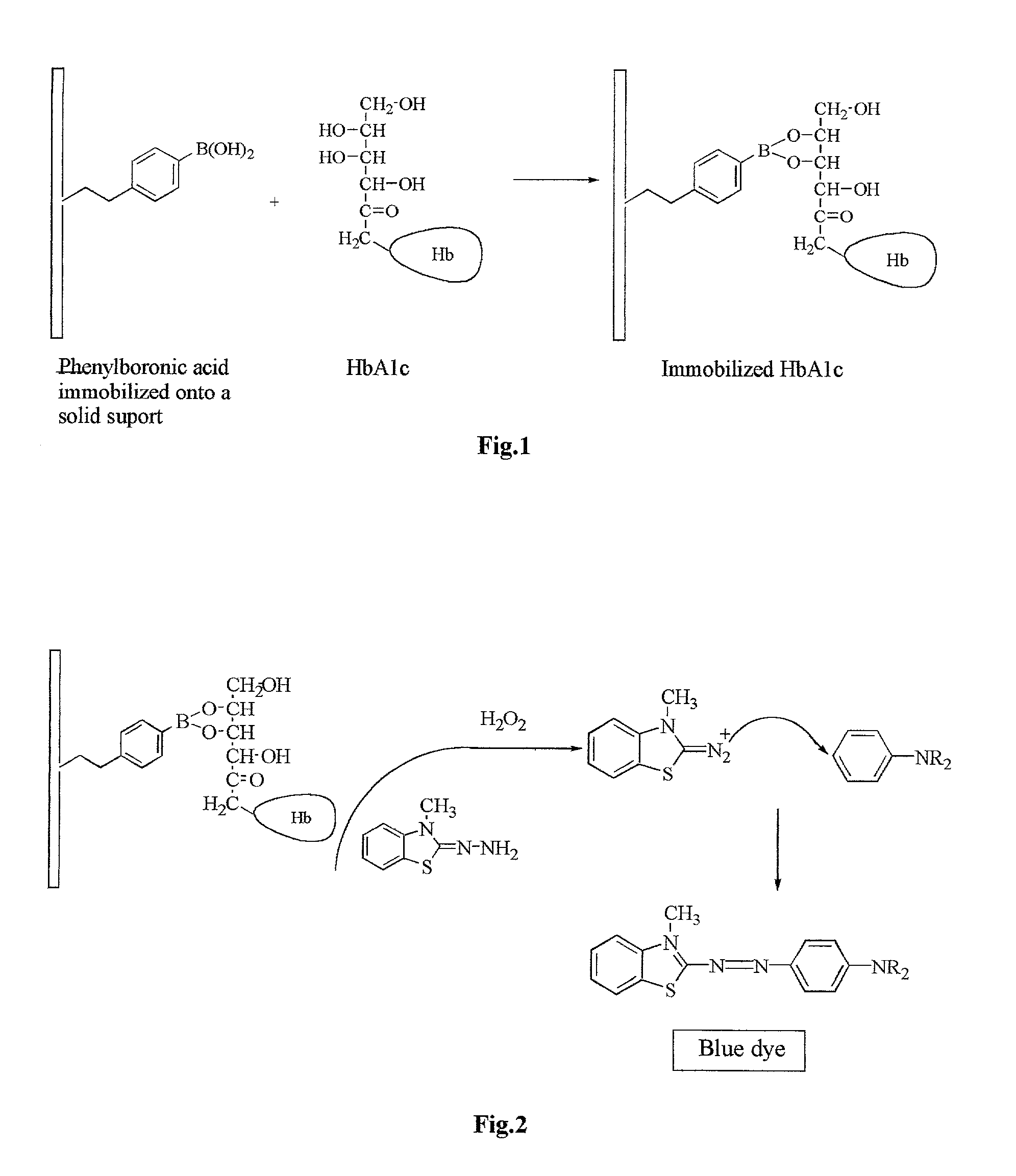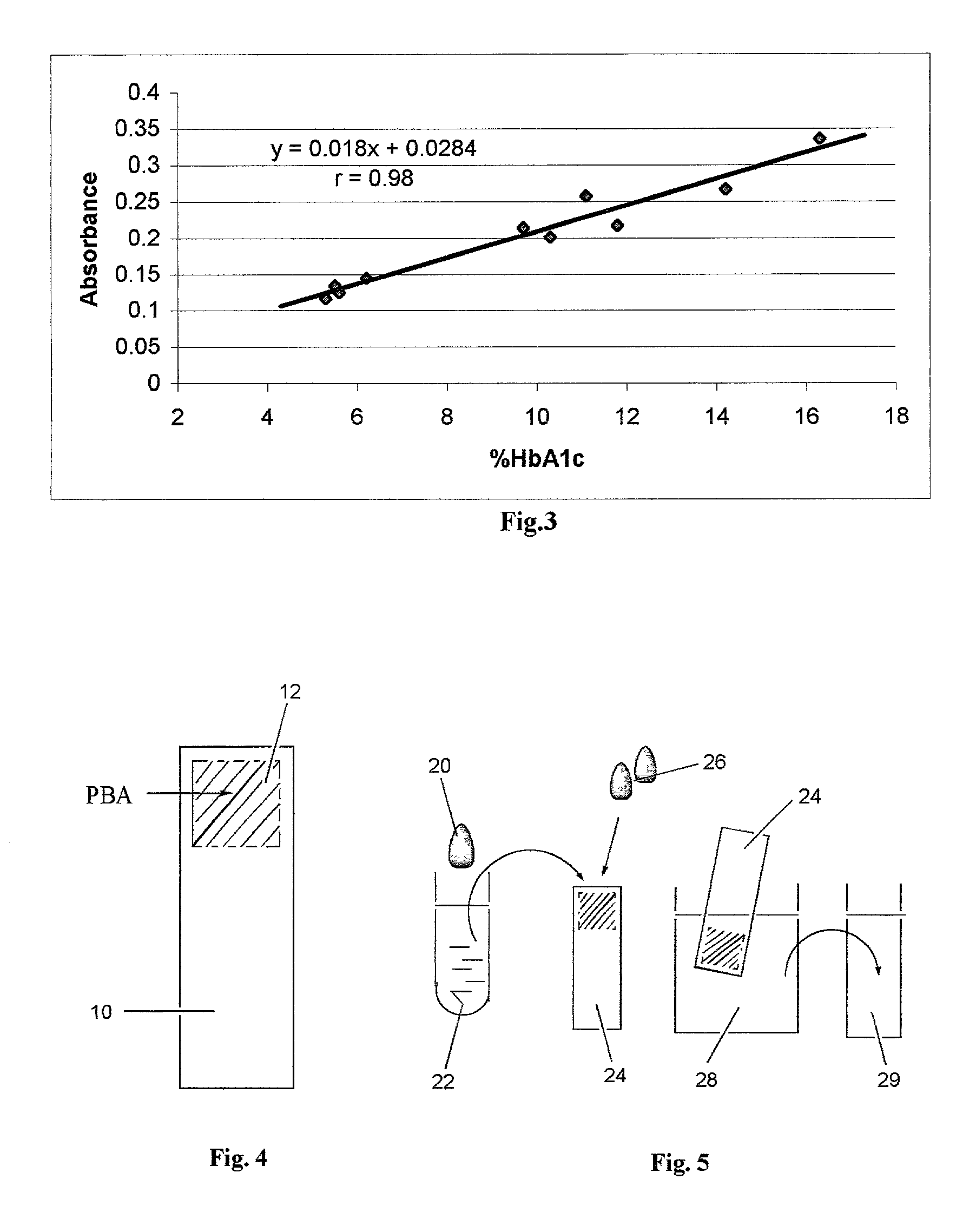Method for quantitative determination of glycated hemoglobin
- Summary
- Abstract
- Description
- Claims
- Application Information
AI Technical Summary
Problems solved by technology
Method used
Image
Examples
example 1
Manual Format
[0035] Whole blood sample (100 .mu.l) was mixed with 250 .mu.l of binding buffer (Taurine, pH 9) and the mixture was incubated with 25 mg of 3-aminophenylboronic acid immobilized onto acrylic beads (Sigma, Cat.# A 4046, Ligand immobilized: 300-600 .mu.moles per gram)) for 10 minutes. The beads were filtered off and washed with phosphate buffer (50 mM, pH 7). The beads were transferred into a vial, and color development solutions containing the color forming coupler and the oxidizable color-developing compound were added in the following order:
[0036] phosphate buffer (50 mM, pH 7) . . . 2.7 ml
[0037] 3-methyl-2-benzothiazolinone hydrazone hydrochloride solution (MBTH)(0.035%) . . . 100 .mu.l
[0038] N,N-diethylaniline (0.08M) . . . 100 .mu.l
[0039] Finally 100 .mu.l of H.sub.2O.sub.2 (20 mM) was added. The mixture was gently agitated at room temperature for 3 minutes, and the absorbance readings at 596 nm were measured on a spectrophotometer. Ten blood samples with HbA.sub.1...
example 2
Dip Stick Format (Spectrophotometric Measurement)
[0041] The key component of the proposed device is a membrane attached to a plastic strip (FIG. 4). The membrane 12 contains immobilized phenylboronic acid (PBA) and is attached to a backing 10. Biodyne.RTM. C membrane (Pall Gelman Lab., Ann Arbor, Mich.) used in this example is a nylon 6,6 membrane with pore surface populated by carboxylic groups. Onto this membrane is immobilized 3-Aminophenylboronic acid (APBA) using dicyclohexylcarbodiimide (DCC) to form covalent amide bonds.
[0042] Immobilization was accomplished by incubating of the membrane with a solution of APBA and DCC in tetrahydrofuran (THF) for two days at ambient temperature. An excess of APBA was used to block all carboxylic groups and prevent nonspecific binding. In order to remove reaction components, the membrane was washed successively with dimethylformamid (DMF), THF and acetone. The washing continued until the washing solution showed no absorbance in the 200-300 nm...
example 3
Dip Stick Format (Reflectometric Measurement)
[0065] In order to fix dye formed during the test to the membrane surface, NEAP was immobilized onto the membrane along with APBA. A piece of Biodyne C Membrane (4.times.4 cm) was incubated with a solution of APBA (80 mg) and DCC (0.2 g) in dry THF (8 ml) for 24 hours. The membrane was washed by agitating with following solvents for 15 min each: THF (4.times.15 ml), DMF (15 ml), THF (15 ml), and acetone (2.times.15 ml). The washed membrane was briefly dried under the hood and incubated for 24 hours with a solution of NEAP 2HCl (0.25g), diisopropylethylamine (0.4 ml) and DCC (0.8g) in dry DMF (10 ml). The membrane was washed by agitating with following solvents for 15 min each: THF (2.times.15 ml), DMF (15 ml), THF (15 ml), and acetone (2.times.15 ml). A dip stick was produced from the dried membrane as in Example 2.
[0066] The assay procedure was generally the same as in Example 2 except that the colored dye is trapped / fixed on the membran...
PUM
 Login to View More
Login to View More Abstract
Description
Claims
Application Information
 Login to View More
Login to View More - R&D
- Intellectual Property
- Life Sciences
- Materials
- Tech Scout
- Unparalleled Data Quality
- Higher Quality Content
- 60% Fewer Hallucinations
Browse by: Latest US Patents, China's latest patents, Technical Efficacy Thesaurus, Application Domain, Technology Topic, Popular Technical Reports.
© 2025 PatSnap. All rights reserved.Legal|Privacy policy|Modern Slavery Act Transparency Statement|Sitemap|About US| Contact US: help@patsnap.com



